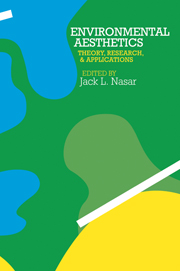Book contents
- Frontmatter
- Contents
- List of figures
- List of tables
- List of contributors and participants
- Acknowledgments
- Preface
- Section I Theory
- Section II Empirical studies
- Editor's introduction
- A Methodological comments
- B Architectural interiors
- C Architectural exteriors
- Editor's introduction
- 14 A study of meaning and architecture
- 15 Predicting user responses to buildings
- 16 Dimensions in the perception of architecture: identification and interpretation of dimensions of similarity
- 17 Contextual compatibility in architecture: an issue of personal taste?
- D Urban scenes
- E Natural and rural scenes
- Section III Applications
- References
- Index of authors
- Subject index
16 - Dimensions in the perception of architecture: identification and interpretation of dimensions of similarity
Published online by Cambridge University Press: 05 September 2013
- Frontmatter
- Contents
- List of figures
- List of tables
- List of contributors and participants
- Acknowledgments
- Preface
- Section I Theory
- Section II Empirical studies
- Editor's introduction
- A Methodological comments
- B Architectural interiors
- C Architectural exteriors
- Editor's introduction
- 14 A study of meaning and architecture
- 15 Predicting user responses to buildings
- 16 Dimensions in the perception of architecture: identification and interpretation of dimensions of similarity
- 17 Contextual compatibility in architecture: an issue of personal taste?
- D Urban scenes
- E Natural and rural scenes
- Section III Applications
- References
- Index of authors
- Subject index
Summary
Introduction
Environmental and architectural psychology have expanded and made great headway in recent years. But almost all the research that has so far been done in these areas suffers from two limitations. First, investigators have relied more or less exclusively on verbal judgments of one kind or another. Verbal responses are of interest in themselves, and they are frequently assumed to provide information about attitudes on which nonverbal forms of behavior depend. However, work in such diverse fields as social psychology, market research, and experimental aesthetics (see Berlyne, 1974a) shows that what people do cannot always be predicted from what they say, in accordance with assumptions that are often adopted. So there is an urgent need to supplement verbal measures with nonverbal measures.
Second, investigators have generally requested subjects to rate environments, buildings, or other stimuli for particular attributes that were chosen because the investigators thought them likely to be important and revealing. They thought so partly because of their own intuitions and everyday-life experience and partly for theoretical reasons. But there is, of course, the danger that the attributes chosen, which must in any case represent only a small part of the variables that can distinguish stimulus patterns, do not actually include the most important ones and will not therefore provide guidance toward fundamental dimensions of perception or emotional reactions.
- Type
- Chapter
- Information
- Environmental AestheticsTheory, Research, and Application, pp. 212 - 227Publisher: Cambridge University PressPrint publication year: 1988



